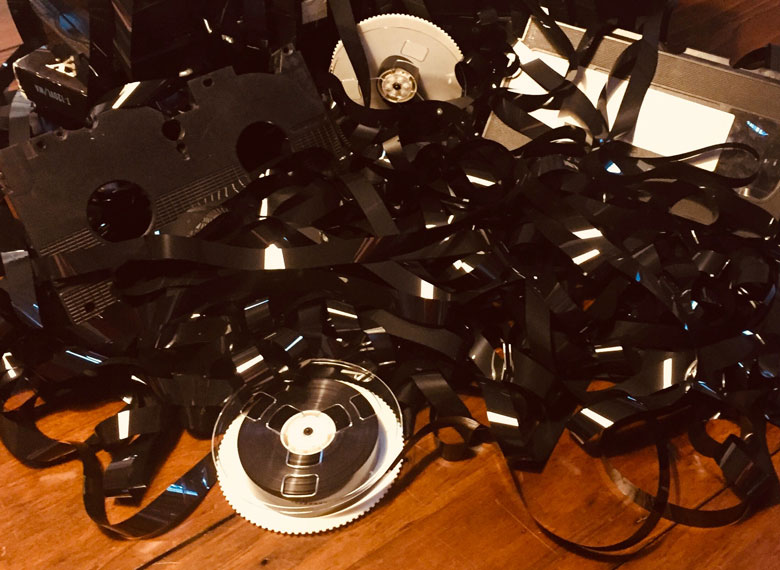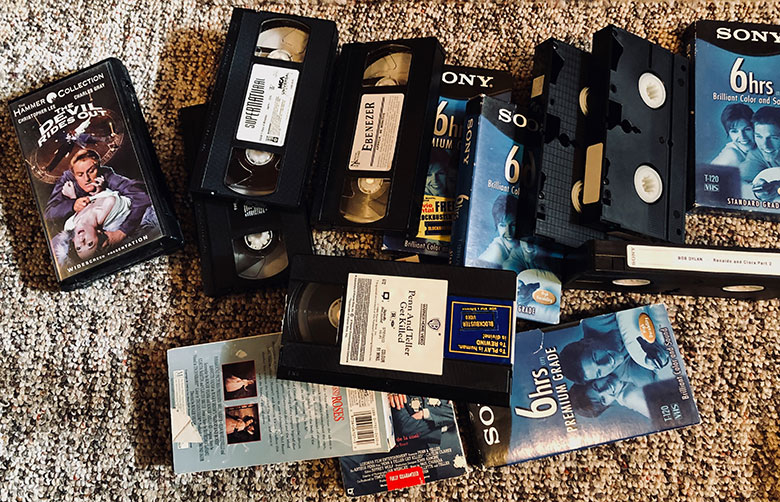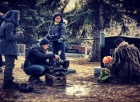A while back I bought a DVD of The Mephisto Waltz (1971). I had last seen this minor entry in the cycle of Satanic horror films that followed Rosemary’s Baby (1968) sometime in my mid-teens. The Mephisto Waltz is a derivate film directed by Paul Wendkos and enlivened by a strong, odd cast, including Jacqueline Bisset and Alan Alda. A lot of the film I remembered surprisingly well, down to individual lines of dialogue, despite not having seen it in around 20 years. However, it has a particularly unusual ending that I was surprised to find that I did not remember at all. My guess is that the reason why I didn’t remember the ending of The Mephisto Waltz is that I never saw it, that my VHS tape ran out before it was over, leaving the film half-finished in my imagination for two decades. Reflecting on this experience swept me into a tide of memories of a vanished mode of spectatorship, one that had made me into a cinephile.
I first saw The Mephisto Waltz not on a commercial VHS tape, either rented or purchased, but as one taped off of broadcast television. I last saw it on MovieMax, a cable channel that played older movies in the mid-1990s. Or to be more precise, I taped it off MovieMax and watched it sometime later, typical of my viewing practices in this formative period as a film watcher. It was a mode of viewership nestled between cable television and video, enabled by two cheap VCRs, a slate of blank tapes, and facilitated by a function called “time record".
Some readers may need an explanation here, since I am describing a mode of viewership that generally is no more. While VCR technology facilitated my entry into cinephilia, it was not principally through rentals. My neighbourhood only had a large Rogers video store; the quirky little independent video store, akin to Quentin Tarantino’s fabled origin story as a humble store clerk, was not part of my experience. Given this limitation, my procedure was this: every week, the TV guide would arrive – not the classy TV Guide but the more generic equivalent that came in the paper.
I would comb it for films I wanted to see, mostly airing in the middle of the night. “Ah, Ikiru (1952) is on Thursday night. I’ll record that for sure. And Village of the Damned (1960), finally! It’s odd that I saw its sequel first. Landscape in the Mist (1988) sounds like a challenge. Here’s The Paradine Case (1947) . . . reputed to be one of the ‘completists only’ Hitchcock films but I’ll give a look. Scarecrow (1973) and Carny (1980) are back to back – is there enough space on the tape?” I could watch few live, so I relied on two VCRs and countless tapes to record as many as I could to then watch at my leisure – before school, over dinner, in the evenings, whenever time permitted, 15 minutes here and 30 minutes there. I could never be satisfied because there were always more, more than I could possibly see.
And I was interested in most anything. Film noirs, musicals, Westerns, Biblical epics, ‘80s sex comedies, European art cinema, melodramas, low budget science fiction, you name it. Though I took a particular interest in the horror genre and rarely passed up even its most obscure entries. Sometimes I found these films on specialty channels like MovieMax and the more high art focused Bravo! and Showcase, plus eventually TCM, Space, AMC, and others. But even channels like CBC and A&E filled their overnight schedules with movies from decades past, no doubt very cheap programming for them. Films, especially older ones, cast a mysterious spell on me, fascinating and compelling me with visions of what was and what could have been. And I saw all that I could, the VCRs whirring constantly as I captured more films than I could count.
It was a mode of viewership nestled between cable television and video, enabled by two cheap VCRs, a slate of blank tapes, and facilitated by a function called “time record".
What I did not do was save the tapes. I knew people who created a treasury of taped material, even printed off specialty labels and sleeves to mark them, but I was not so organized. Rather I embraced the ephemerality of the experience, generally watching a film exactly once before casting them back into the void, as it were, by taping over it.
Supposedly “inaccessible” films, those that had largely vanished due to neglect or otherwise, occasionally surfaced on television. I definitely watched William Friedkin’s controversial Cruising (1980), starring Al Pacino as a detective who infiltrates the gay leather scene in New York in search of a killer, well before I was aware it was supposed to be an “unavailable” film. When preparing a class on the New Hollywood Cinema, I briefly contemplated screening Paul Mazursky’s An Unmarried Woman (1978) only to realize that the only DVD is an expensive import. It made me wish I had saved the tape from when I recorded it off TV sometime in the late ‘90s. And every now and again I yearn to renew my acquaintance with the zero-budget Montreal vampire comedy Draghoula (1995).
My viewing choices were shaped by a number of tastemakers. I surrounded myself by a set of books, some of which I owned (mostly scrounged from used bookstores), many more courtesy of my part-time employer, the Calgary Public Library. These included books by critics like Pauline Kael, Roger Ebert, Jay Scott, and Danny Peary, sprawling catalogues like Leonard Maltin’s Film Guide and Videohound’s Golden Movie Retriever and more specialized texts about individual films and genres. I am not sure I can quite describe the excitement of noticing in the TV guide that a canonical classic that never seemed to be on – like Robert Wise’s The Haunting (1963) – was finally playing. Of course, in principle I could have bought a VHS tape of The Haunting at any time but it probably would have required an expensive special order, and besides, the hunt for television airings was more thrilling. The Internet became a larger factor as the ‘90s continued, and I found communities in which to discuss, recommend, and analyze films both past and present, and to begin to hone my own skills in the evaluation and analysis of films.
This discussion would be incomplete without mentioning the salacious material, which would largely air late at night on weekends (including the infamous Drambuie Showcase Revue). The audience for international art cinema in the 1960s and 1970s was fuelled by the fact that these films were full of nudity and sexuality, and the same was true of my latter-day re-consumption. I wonder if tags like “Contains explicit sexuality” functioned more often as warnings or as enticements. I probably wasn’t older than 13 when I first saw Last Tango in Paris (1972), and I remember scandalizing a classmate by lending him a tape of the finale of Star Trek: The Next Generation (1987-1994) that suddenly turned into Bertolucci’s incest drama Luna (1979). But it wasn’t all such lofty fare: Canadian networks showed and reshowed softcore items like Emmanuelle, The Joys of a Woman (1975), The Au Pair Girls (1972), and the sophomoric spoof Flesh Gordon (1974) with bizarre regularity.
. . . I embraced the ephemerality of the experience, generally watching a film exactly once before casting them back into the void, as it were, by taping over it.
Yet this was not all pleasure. Sometimes it felt like work. With a solemn sense of duty I set out to watch every film that won the Oscar for Best Picture. That meant tracking down sublimely forgettable films like Cavalcade (1933) and The Greatest Show on Earth (1952). I remember committing the cardinal sin of largely fast forwarding through the interminable The Great Ziegfeld (1936) – I hope the cinema gods forgive me. And the sheer volume of material was more than I could practically process. In a given week at least 20 or 30 films I in principle wanted to watch would play on TV, and I had time for maybe eight or ten of those. Sometimes so many would be playing at the same time that two VCRs could not capture them. And finding time to watch them wasn’t easy, especially as I was also going to the theatres for new films once or twice a week.
The process of recording was an inexact science. Set the wrong time or the wrong channel and the tape might fill up with infomercials or dead air. Misjudge the amount of time left on the tape and an audible “CLICK!” signals the incompleteness of the film. I remember losing the last few minutes of The Prime of Miss Jean Brodie (1969) and, long before plot summaries proliferated online, seeking out people on the Internet to tell me how it ended. I’ve never actually gone back to watch the rest of it, so consequently my mind holds a visualization of Maggie Smith yelling “Assassin!” that is probably completely different from the film itself.
Another real downside was that the films aired in decidedly compromised fashions. Almost nothing was in a widescreen format, so most any film past the early 1950s was literally incomplete, often crudely hacked away at its margins. But I had only a dim awareness of this, nor was I too concerned with picture or sound fidelity. I was more conscious of when films were cut and re-edited for television, and on network screenings also redubbed. I recall laughing in disbelief at a scene in Boyz in the Hood (1991) where a string of profanity was replaced by lines like “Stupid old cops!” At this writing its director, John Singleton, has recently died and I feel a flash of shame that I never went back and watched his most famous film without that ridiculous bowdlerization.
My “let them come to me” approach to film viewing also left real holes in my cinematic education. For example, I cannot recall ever seeing a John Cassavetes film airing on television; it was only years later before I was able to see Shadows (1959), Faces (1968), A Women Under the Influence (1974) and more. I am virtually sure I never saw a Jean-Luc Godard film before Contempt (1963) showed at the Plaza Theatre in 2000 (a poor date movie, it turns out). Pier Paolo Pasolini was another filmmaker to whom I had little exposure. With the possible exception of The Gospel According to St. Matthew (1964), I can’t recall seeing any of his films pop up on television. I was in graduate school before I ever watched a Fassbinder film. Asian films were mostly limited to films by established auteurs, laurelled festival offerings like Raise the Red Lantern (1991) and Farewell My Concubine (1993) and the odd action film. I recall no more than a handful of silent films, and there was of course no trace of experimental cinema.
Being in near constant use was bad for the tapes. Sometimes they would snap and need to be discarded altogether; more often, segments would wear and become unusable, so that every time you taped over it would have the same unwatchable three-minute span. In general, I did not care much about the quality of my recordings, perhaps because I didn’t know what I was missing. My experience of these films, looking back, was of a decidedly compromised character. Quantity over quality.
But on the whole, I had a broad immersion of film history, and this gave me a major bonus when I reached my M.A. in Film Studies at Carleton University. There was still so much I hadn’t seen, and certainly lots of critical perspectives I had not yet been exposed to, but my practical experience as a film viewer was a real asset. More recently, as I have travelled to major archives and found myself looking at obscure silent films that are sometimes only available in a single place, I again feel a kind of thrill that reminds me most of those excited days of spotting just the right title in the TV listings.
Years ago the manufacture of VCRs ended. I still own one because I still have VHS tapes of films unavailable in other formats, though I have not used it in a while. I have a hard time imagining the VCR achieving some vinyl record style resurrection through nostalgia, and I am not nostalgic for the technology but for the practice. As odd as it may sound, I miss setting time records. I miss that swell of excitement when a long-sought film finally popped up on the TV listings, and even that disappointment when a tape snaps. I ought to be contented with the much more immaculate, immaterial, and reliable body of media available to me now; indeed we live in a golden age of accessibility. For whatever mixed blessings that the digital age has provided, there is an unprecedented level of access to cinema history at our fingertips. And yet when I look at the endless scrolling list of films available on Netflix, to say nothing of all the classic cinema freely available on YouTube and the like, I think of how daunting it must be to a budding cinephile: where to start? I realize how vital scarcity was to my cinematic education. The flow of films was piecemeal, scattered, limited, and thus manageable.






